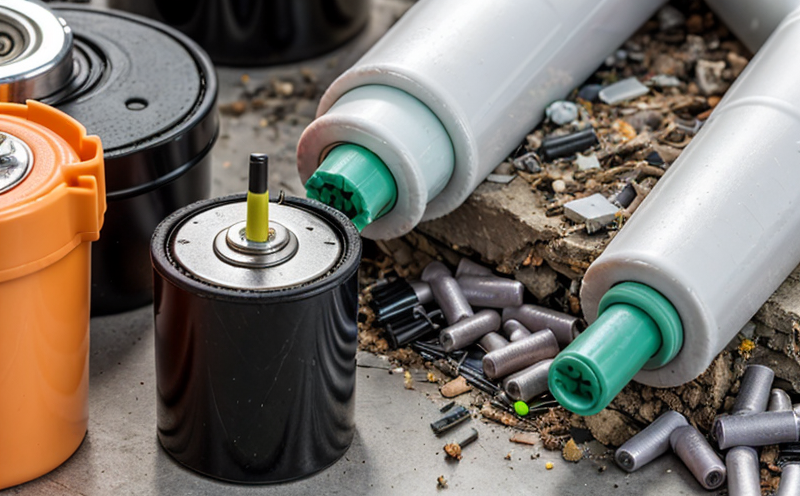UNE EN 50342 End-of-Life Testing of Automotive Lead-Acid Batteries
The UNE EN 50342 standard provides a framework for comprehensive end-of-life testing of automotive lead-acid batteries. This service is designed to ensure the safe and environmentally responsible recycling and disposal of spent automotive batteries, which are one of the largest contributors to hazardous waste streams.
UNE EN 50342 covers various aspects of battery testing at the end of their useful life, including but not limited to: capacity retention tests, sulfation levels, internal resistance measurement, visual inspection for damage or corrosion, and more. This standard is crucial in maintaining high safety standards and preventing environmental contamination.
During this process, our laboratory adheres strictly to UNE EN 50342 guidelines, ensuring that all testing procedures are conducted with precision and accuracy. Our team of experts uses state-of-the-art equipment and methodologies to provide reliable data for decision-making purposes. This includes the use of advanced battery testers capable of measuring voltage, internal resistance, specific gravity, and other critical parameters.
The first step in our process involves receiving the batteries from clients or collection points. These batteries are then prepared according to UNE EN 50342 requirements. This preparation ensures that all samples are consistent and comparable for testing purposes. Once prepared, the batteries undergo a series of tests aimed at assessing their remaining capacity, internal resistance, and other relevant metrics.
Capacity retention tests are conducted by discharging the battery to a predetermined voltage level while recording the ampere-hours delivered during discharge. This helps in determining how much charge remains in the battery after its useful life has ended. Sulfation levels are measured using spectroscopic analysis techniques which can detect the presence and extent of lead sulfate crystallization within the plates.
Internal resistance measurement is performed using specialized test equipment that applies a small current through the battery under load conditions. The resulting voltage drop across the internal impedance provides insight into the battery’s health status. Visual inspections are also carried out to check for visible signs of damage, corrosion, or other issues that may affect the recyclability and safety of the battery.
The results from these tests provide valuable information regarding the condition of automotive lead-acid batteries at end-of-life stage. This data is crucial not only for proper recycling but also for understanding trends in battery performance over time which can inform future design improvements.
By adhering strictly to UNE EN 50342 standards, we ensure that our testing processes are consistent and reliable across different clients and locations. Our team of experienced professionals is committed to delivering accurate results that meet the highest industry standards. This commitment extends beyond just meeting regulatory requirements; it encompasses a broader responsibility towards protecting public health and preserving natural resources.
The implementation of UNE EN 50342 helps us contribute significantly to sustainable development goals by promoting responsible management practices for hazardous waste materials like automotive lead-acid batteries. It supports efforts aimed at reducing environmental impact while ensuring product safety throughout its lifecycle.
Industry Applications
The UNE EN 50342 standard finds application across various sectors including automotive manufacturing, transportation services, and recycling industries. Automotive manufacturers often rely on this testing method during the design phase to optimize battery performance before they reach end-of-life stage. Transportation service providers use it post-delivery to ensure that batteries meet expected operational standards.
For recycling companies, compliance with UNE EN 50342 ensures adherence to environmental regulations which is essential for obtaining licenses and permits required by law. It also helps in identifying batteries suitable for reconditioning versus those needing disposal via specialized facilities designed for handling hazardous materials safely.
In addition to these key industries, government bodies responsible for regulating waste management practices benefit greatly from implementing UNE EN 50342 standards within their policies and guidelines. By doing so, they can better monitor compliance levels among producers and recyclers ensuring long-term sustainability objectives are met effectively.
Customer Impact and Satisfaction
- Informed Decision Making: Provides reliable data for decision-making purposes, ensuring safe and responsible management practices for hazardous waste materials like automotive lead-acid batteries.
- Better Compliance: Ensures that all testing procedures are conducted with precision and accuracy as per UNE EN 50342 guidelines. This helps clients meet regulatory requirements more effectively.
Environmental and Sustainability Contributions
- Reduces Environmental Impact: By promoting responsible management practices for hazardous waste materials like automotive lead-acid batteries, it supports efforts aimed at preserving natural resources and protecting public health.
- Promotes Sustainable Development Goals: Ensures that the industry can better monitor compliance levels among producers and recyclers ensuring long-term sustainability objectives are met effectively.





